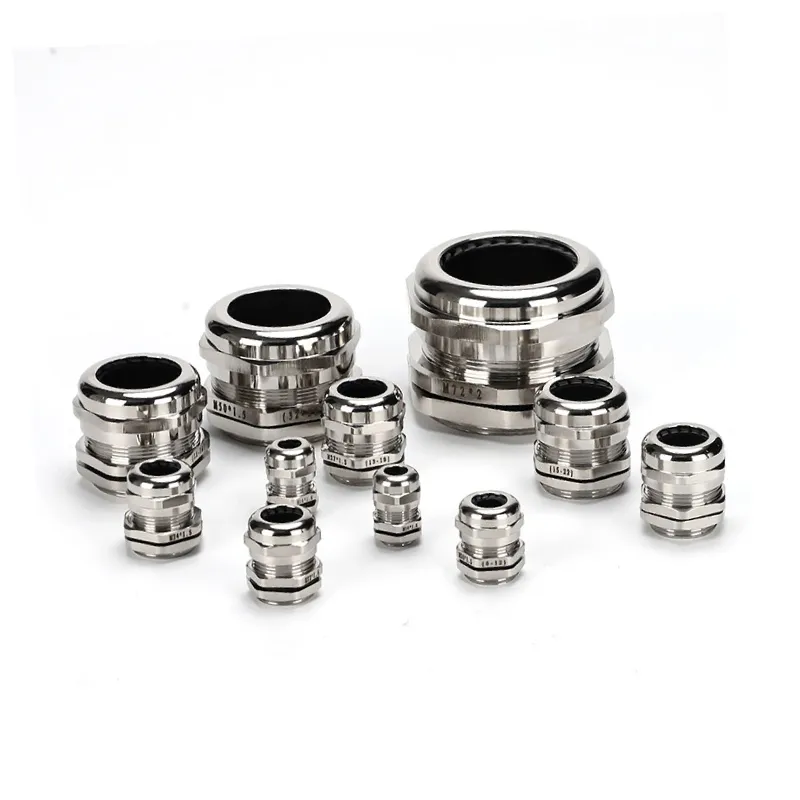금속 케이블 글랜드의 생산은 야금 전문 지식, 정밀 엔지니어링, 엄격한 품질 보증의 정교한 상호작용을 나타냅니다. 항공우주부터 해양 에너지에 이르기까지 다양한 산업에서 전기 연결을 보호하고 보안을 유지하도록 설계된 이 중요한 부품은 세심하게 조율된 제조 과정을 거칩니다. 이 보고서는 산업 관행, 기술 사양 및 재료 과학에서 얻은 인사이트를 종합하여 케이블 글랜드 생산의 기반이 되는 복잡한 프로세스 체인을 설명합니다.

기본 디자인 및 소재 선택
전산 설계 통합
제조 공정은 3D CAD 소프트웨어가 기계적 하중, 열팽창 계수, 전자기 간섭 프로파일을 고려한 정밀한 사양을 생성하는 고급 전산 모델링으로 시작됩니다. 엔지니어는 유한 요소 분석(FEA)을 통합하여 작동 조건에서 부품 전체의 응력 분포를 시뮬레이션하여 스테인리스 스틸 변형의 인장 강도가 500MPa를 초과하도록 형상을 최적화합니다.
재료 선택
소재 선택은 매우 중요한 역할을 합니다:
- 황동 합금(CuZn39Pb3): 높은 가공성, 내식성, 니켈 도금을 통한 향상된 서비스 수명으로 일반 용도에 사용됩니다.
- 오스테나이트 계 스테인리스강(AISI 303/316L): 해양 및 화학 환경에서 선호되며 우수한 내공극성을 제공합니다.
- 알루미늄 합금(6061-T6): 최적의 중량 대비 강도 비율로 항공우주 및 자동차 애플리케이션에 이상적입니다.
사양은 전산 유체 역학(CFD) 모델을 통해 검증된 케이블 고정력 및 IP68 침입 보호 프로토콜에 대한 BS EN 62444와 같은 표준을 준수합니다.
정밀 제조 기술
금속 가공
이 과정은 주조 또는 단조 방식으로 시작됩니다:
- 투자 캐스팅: 0.15mm의 치수 공차로 복잡한 형상을 지원하며, 구조적 안정성을 위해 주조 후 열처리가 포함되어 있습니다.
- 핫 단조: 입자 흐름 정렬을 통해 가공할 때보다 내피로성이 40% 향상됩니다.
CNC 가공 작업
다축 CNC 가공으로 정밀도를 보장합니다:
- 선회: 표면 마감 Ra ≤1.6μm로 가공되고 정확한 ISO 68-1 사양에 따라 유지되는 나사산.
- 밀링: 진동 방지 플랜지 및 관련 구성 요소의 윤곽을 활성화합니다.
- 드릴링/태핑: 케이블 통로에서 0.02mm/mm 이내의 직각을 유지하고 내부 나사산을 형성합니다.
가공 후 연마 흐름 가공(AFM)으로 미세 버를 제거하여 IP68 씰링 무결성을 보장합니다.
조립 및 씰링 시스템 통합
다단계 어셈블리 프로토콜
컴포넌트 통합은 정확한 프로토콜을 준수합니다:
- 씰 설치: 계면 압력이 3.5MPa를 초과하는 플루오로실리콘 오링 압입형입니다.
- 아머 클램핑: 냉간 단조 황동 페룰은 1.5kN 이상의 풀아웃 저항을 제공합니다.
- 토크 제한 어셈블리: 공압 드라이버는 과압축을 피하면서 제어된 토크(12~35Nm)를 가합니다.
고급 이중 밀봉 메커니즘을 통해 테스트 중 헬륨 누출률이 1×10-⁶ mbar-L/s 미만임을 보장합니다.
품질 보증 및 성능 검증
계측 검증
레이저 스캐닝 헤드가 장착된 CMM을 사용하여 중요 치수를 확인합니다. 나사산 동심도, Go/No-Go 게이지 준수 및 기타 미세 공차를 꼼꼼하게 검사합니다.
환경 스트레스 테스트
배치 샘플링은 다음과 같은 엄격한 테스트를 거칩니다:
- 열 순환: 250 사이클에 걸쳐 -40°C ~ +150°C에서 씰 압축 세팅을 모니터링합니다.
- 염수 분무 테스트: ASTM B117 표준에 따라 스테인리스 스틸 패시베이션을 보장합니다.
- 진동 테스트: 무작위 진동 프로파일에서 내구성을 확인합니다(MIL-STD-810G).
전기화학 임피던스 분광법(EIS)은 황동 부품의 탈아연화에 대한 취약성을 방지합니다.
지속 가능한 제조 혁신
폐쇄 루프 재료 시스템
지속 가능성 관행에는 다음이 포함됩니다:
- 황동 스와프를 재활용하여 최대 98%의 재료를 회수할 수 있습니다.
- 수성 니켈 도금을 사용하여 유해 폐기물을 줄입니다.
에너지 효율적인 프로세스
- 펄스 전기 도금: 균일한 코팅을 제공하면서 에너지 사용량을 40%까지 줄입니다.
- 재생 열 산화제: 주조 작업에서 발생하는 열을 포집하고 용도를 변경하여 VOC 배출을 줄입니다.
결론
금속 케이블 글랜드 제조는 전통적인 야금과 인더스트리 4.0 기술의 융합을 대표합니다. 전산 모델링부터 지속 가능한 생산 이니셔티브에 이르기까지 모든 단계에서 정밀성과 환경 보호가 강조됩니다. 산업 수요가 진화함에 따라 제조업체는 그래핀 도핑 복합재 및 적층 제조 기술과 같은 재료로 혁신하여 글로벌 전기화 인프라에서 이러한 필수 부품의 지속적인 관련성을 보장합니다.


